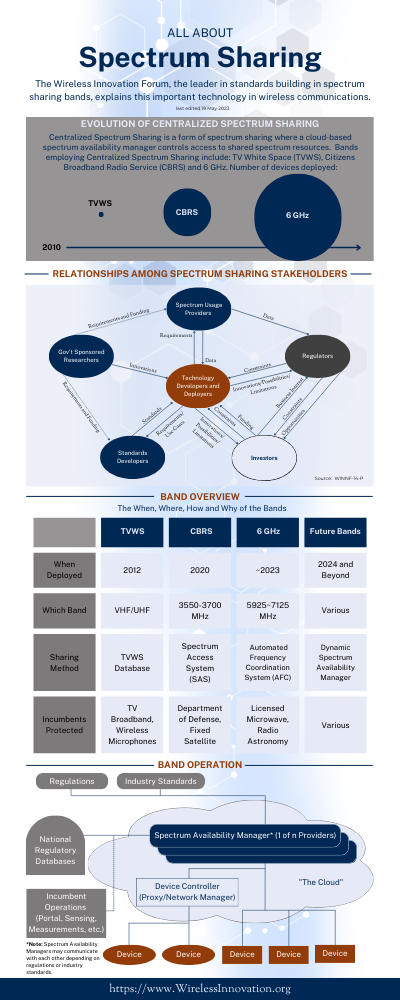- Home
- Knowledge Center
- Reports, Recommendations and Specifications
- Information Documents
- All About Spectrum Sharing Infographic
- Free Webinars
- Tech Talks
- Setting the Standard Video Blog
- Beyond the Radio Dial Video Blog
- Conference Proceedings
- Workshop Proceedings
- Springer Journals
- Market Studies
- What is the SCA?
- Issue Submissions
- Reference Implementations
- What is SDR?
- What are CR and DSA?
- About Us
- Events
- News
- Projects & Committees
- Members
- Join the Forum
Wireless Innovation Forum Top Ten Most Wanted InnovationsInnovation #5: Flexible, Extensible, and Secure Transportation Communication Framework, Architecture, and Management5.1 Executive SummarySelf-driving cars are anticipated to emerge in the next decade as an everyday technology. Public anticipation of this technology is keen, given the potential to save countless numbers of lives, substantially reduce travel times, and give freedom to those who are unable to drive. While the current view is that cars will have a great deal of autonomy through a vast array of sensors, vehicles will need to coordinate with other vehicles (i.e., signal the need for a lane change), infrastructure (i.e., knowing when a signal will change or a rail crossing will engage), and pedestrians (provide additional safety to pedestrians in addition to visual cues). While the idea of vehicular communications has been around for some time (such as DSRC, or Dedicated Short Range Communications), it has not been commercially attractive and hence has seen very limited deployment. What has changed is that electronic safety measures have become much more appreciated by the public with the advent of such devices as lane change monitoring, automatic braking, and smart cruise control. New technologies such as low latency communications and machine-to-machine communications are also emerging and supportive of vehicular communications. 3GPP Releases 14 and 15 describe a new technology called cV2x that has promise for integrating vehicular communications into the cellular network. Refinements to cV2x will be forthcoming in Release 16 and likely further refinements will happen in later releases. At the same time, the slow uptake on DSRC has caused the FCC to consider allowing WiFI to operate in the band 5.850-5.925 GHz that had been set aside for vehicular communications. The business model for vehicular communications is becoming more attractive for governments and commercial companies. Increasing traffic flow without building new roads or lanes is attractive to governments that need low-cost solutions to traffic congestion. New business areas and revenue and access to high volume data customers and the ability to integrate vehicular communications into the cellular infrastructure is attractive to service providers. Car manufactures are able to entice new car buyers with new technologies that promise safety and convenience. Yet, there are hurdles to realization of vehicular communications. The regulatory environment is in flux regarding the spectrum availability for vehicular communications. Should or will one standard exist for the vehicular communications band? If not, how will various standards co-exist in the band especially when safety applications are supported? What will be the impact of WiFi in adjacent bands or even co-channel with vehicular communications? How can technology improvements progress when not all vehicles may not have the latest technology? 5.2 Application How will this technology make an impact? Creating this Framework will allow for a quicker, smoother, and more risk adverse deployment of vehicular communications. The framework will also facilitate a competitive business environment, minimize regulatory decisions, and facilitate rapid progress in improving vehicular communication technology. 5.3 Description What is needed to support vehicular communications is the formulation of a flexible, extensible, and secure transportation communications framework. Such a framework will enable a competitive ecosystem of service providers, manufacturers, and deployment services to collaborate and develop best deployment practices. This framework needs a common language, technical expectations, security mechanisms, and open interfaces. The framework developed must be able to live through the life of a car, spanning 20 years or more and hence should evolve with time along with the applications it supports. It needs to be compatible with the regulatory framework of various nations yet be customizable for the specific needs of a nation or region within a nation. Such a framework will require SDR innovations beyond what is available today, primarily because of latency concerns. Something analogous to a Software Communication Architecture (SCA) is needed. However, end-to-end response time of 1ms or less will be needed and will become the key technical driver in designing the architecture and implementing of the vehicular communication system. Spectrum awareness is a key technology in supporting this framework. It is important for co-existence of dissimilar standards and it is important in the build out of the technology to know when and where communication resources are available and the nature of the interference in that area. Given that safety systems will depend on the availability of spectrum appropriate security measures need to be define, including physical layer security to avoid jamming or spoofing attacks. The policy regards to spectrum for the use in vehicular communications is still in flux, but for now it appears that the FCC will take a hands-off approach and let market forces decide what standards will be deployed in this band and its adjacent channels. This has far reaching implications. Many component technologies are necessary to fulfill the promise of a unifying framework. Key technology areas and their needs are listed below. SDR
Spectrum management
Deployment processes
|



